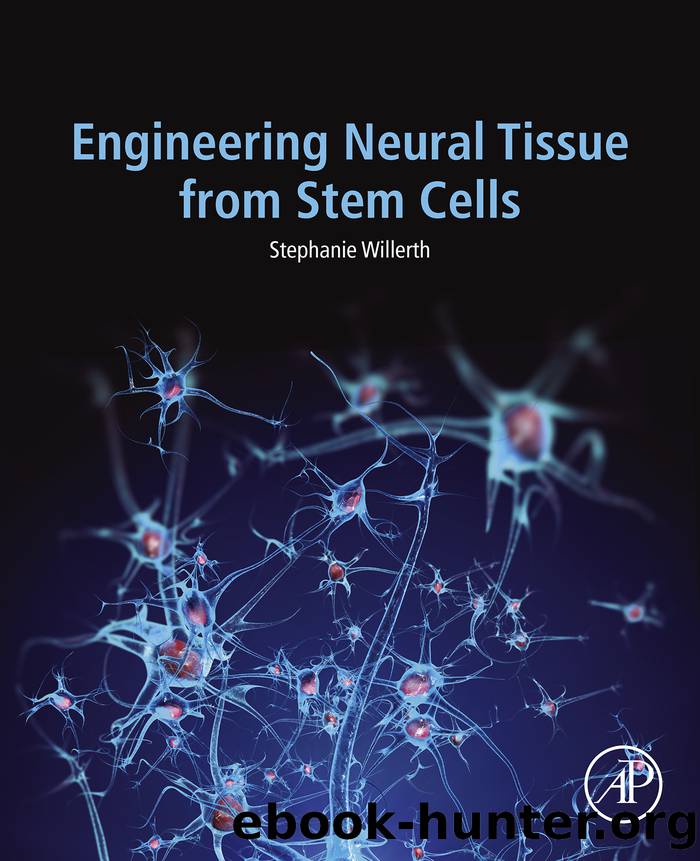Engineering Neural Tissue from Stem Cells by Willerth Stephanie;

Author:Willerth, Stephanie; [Willerth, Stephanie]
Language: eng
Format: epub
Publisher: Elsevier Science & Technology
Published: 2017-07-05T00:00:00+00:00
Fig. 5 Hyaluronan and methylcellulose (HAMC), an injectable hydrogel matrix, improves retinal stem cell (RSC)-derived rod photoreceptor survival after transplantation. (AâD) The absolute numbers of cells surviving in the retina of adult mice 3 weeks posttransplantation in saline versus HAMC vehicle (A). HAMC encourages the posttransplant survival of RSC-derived rods compared to saline as the maturity of the rods increases. Quantification was performed on the percentage of integrating cells (as a fraction of total cells counted in the whole eye) (B) in the neural retina, (C) in the subretinal space, and (D) adherent to the RPE layer. Immature RSC-derived rods show an ability to integrate into host neural retina independent of delivery vehicle. Mean ± SEM of n = 4â8 independent transplants are plotted; âp < 0.05. (E)â(H) Inverted epifluorescent image of immature RSC-derived rods transplanted in saline (E) and HAMC alone (F) both show sparse integration into the ONL and extension of short processes but fail to show extensive integration and mature rod morphology (arrows). Compared to cells injected in saline + AAA (G), mature RSC-derived rods in HAMC (28-day RSC-derived rods in HAMC + AAA) (H) show patches of extensive integration into the ONL and mature rod morphology, including the extension of processes toward the outer plexiform layer and outer segments (arrows), compared to cells injected in saline. Scale bars represent 50 μm. GCL, ganglion cell layer; INL, inner nuclear layer; ONL, outer nuclear layer; RPE, retinal pigment epithelium layer; SRS, subretinal space. Reprinted with permission from Ballios BG, Cooke MJ, Donaldson L, Coles BL, Morshead CM, van der Kooy D, et al. A hyaluronan-based injectable hydrogel improves the survival and integration of stem cell progeny following transplantation. Stem Cell Rep 2015;4(6):1031â45; Taken from https://www.ncbi.nlm.nih.gov/pmc/articles/PMC4471829/.
Overall, the set of studies presented here show how enhanced biological effects can be achieved by combining the effects of multiple bioactive molecules and that such strategies can lead to improvements in function when used as engineered scaffolds for controlling stem cell behavior. While the work discussed in this section is not an exhaustive list of all combinatorial approaches, it does provide an effective overview on how such combinations can be applied to generate bioactive scaffolds for engineering neural tissue.
Download
This site does not store any files on its server. We only index and link to content provided by other sites. Please contact the content providers to delete copyright contents if any and email us, we'll remove relevant links or contents immediately.
Whiskies Galore by Ian Buxton(41524)
Introduction to Aircraft Design (Cambridge Aerospace Series) by John P. Fielding(32882)
Small Unmanned Fixed-wing Aircraft Design by Andrew J. Keane Andras Sobester James P. Scanlan & András Sóbester & James P. Scanlan(32569)
Craft Beer for the Homebrewer by Michael Agnew(17927)
Turbulence by E. J. Noyes(7690)
The Complete Stick Figure Physics Tutorials by Allen Sarah(7135)
Kaplan MCAT General Chemistry Review by Kaplan(6585)
The Thirst by Nesbo Jo(6432)
Bad Blood by John Carreyrou(6270)
Modelling of Convective Heat and Mass Transfer in Rotating Flows by Igor V. Shevchuk(6219)
Learning SQL by Alan Beaulieu(6027)
Weapons of Math Destruction by Cathy O'Neil(5819)
Man-made Catastrophes and Risk Information Concealment by Dmitry Chernov & Didier Sornette(5639)
Digital Minimalism by Cal Newport;(5383)
Life 3.0: Being Human in the Age of Artificial Intelligence by Tegmark Max(5181)
iGen by Jean M. Twenge(5150)
Secrets of Antigravity Propulsion: Tesla, UFOs, and Classified Aerospace Technology by Ph.D. Paul A. Laviolette(4974)
Design of Trajectory Optimization Approach for Space Maneuver Vehicle Skip Entry Problems by Runqi Chai & Al Savvaris & Antonios Tsourdos & Senchun Chai(4837)
Electronic Devices & Circuits by Jacob Millman & Christos C. Halkias(4739)
